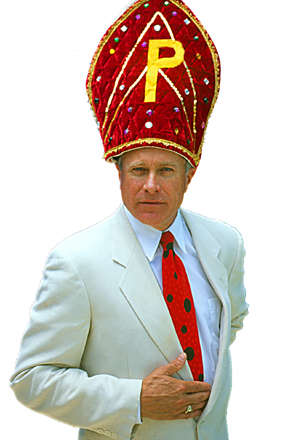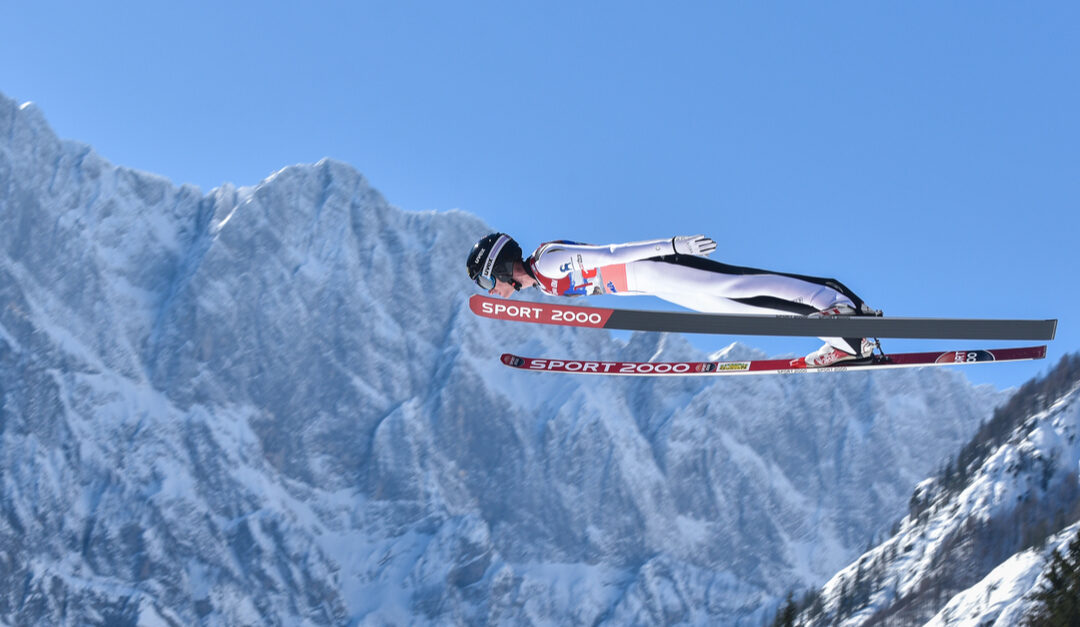
No, this is not your intrepid Pontiff sailing high over the Alps, but an actual Nordic jumper possessing all the skill and talent your blessed Chief Prelate lacks. This is the posture I imagined I was in when I slammed nose-first into a Vermont hillside. I have a very powerful sense of self-delusion.
I was raised in a bygone era marked by a barbarism that would shock the delicate sensibilities of the current generation. Among the degradations endured was the commingling of Nordic and Alpine ski events, apparently honoring some great amateur athletic ideal of the all-around skier. As I was raised as an Alpine skier, I was ill-prepared for the rigors of either cross-country racing or Nordic jumping, as this episode of The Making of a Skier shall illuminate.
Your appreciation of my travails will be enhanced by a fine Armagnac and the understanding that I was born nearly blind. The telescope-thick lenses I wore duct-taped to my face – I’m not kidding; my frames were always broken – would fog the moment they were exposed to winter. In a tuck position, my glasses were worthless anyway, and guess what position is required as prelude to leaping into the void? Please hold this thought as it will come in handy in a few paragraphs.
One more bit of background before proceeding: while I was establishing new lows in the history of Nordic competition, my brother Robin won every Skimeister award in every event we both competed in at Andover and Yale. He always won Skimeister because he was very good in the Alpine events and always won the jumping. As he did again the day my jumping career came to a screeching halt at the home hill of St. Michael’s near Burlington, VT.
One of the really fun cultural quirks of Nordic jumping is that those with the least talent are forced to go first, to warm up the crowd and help wear in the track. As I was demonstrably the least talented jumper there, I got to go first.
Remember, as soon I drop in my tuck I can barely see where I’m going. About all I knew is that fortune favors the brave, so I pulled my goggles over my Mt. Palomar lenses – fogging them instantly – stepped into the fresh track and hurtled downward towards the lip, which I leapt off with all the gusto I could muster.
I was still in what I thought was the laid-out position adopted by those – like my brother – who knew what they were doing, when I stuffed myself face-first into Mother Earth. Did I mention my parents had made the trip up from the homestead in Peru to watch their youngest son try to furrow a patch of Vermont farmland with his forehead?
Here’s the best part: that was my practice jump. I had to scramble to recover my goggles, which it turns out had been shattered by the impact, and my dignity, which was similarly mangled, as quickly as I could, as I was wearing bib number one.
It must have been more like watching a medical experiment than a sport. I’m sweating from the trot uphill to the start, but at least I don’t have any goggles to fog up. Bear in mind, I still have no idea how to do what I’m about to do. I only had one game plan, and I was sticking to it. Geronimo!
Thud! Once again, I had thrown myself like a human lance straight into the hill. Without goggles to buffer the blow, my waffle-thick glasses sliced into my face, opening a gusher just below my eye. They had to pause the event so my blood could be raked out of the out-run.
I have often wondered about the skier from St. Michael’s who wore bib number two. He probably wasn’t much better than I was, and he’s been asked to wait while some bozo’s blood is wiped away. Christening St. Mike’s spanking new jumping hill with my blood can’t have been good for morale. Brother Robin, of course, won.
I was taken to a nearby hospital to get stitched up. Recognizing a likely source of future profits, upon registration the hospital issued me a credit card, which I thought was rubbing it in.
My ability to withstand repeated concussions impressed my coach, but I don’t think he could stand to watch another on his watch, so he permitted me to retire from my career as a face farmer. I still had to enter the customary 15k cross-country race if I wanted to compete in slalom and GS, which was punishment enough.
If my signature move on the jumping hill was to auger in nose-first, my special talent in cross-country was diving out of the track so an overtaking Norwegian who went to Holderness could whiz past. I wasn’t very good at even this simple task, often tripping on the edge of the track and tumbling into the loose snow alongside.
Once I got so over-heated trying to get up that both my glasses and goggles became coated with a thick glaze that smudged the outline of every detail. Somehow in this hazy cocoon I contrived a rare rhythm to my stride, creating an illusion of confidence that only grew stronger as minute after minute went by without hearing someone with a Scandinavian accent yell, “Track!”
An aerial view of my situation would have revealed that I had veered off into what were probably snowshoe tracks that followed a loop through the forest that I was traipsing around all by my lonesome. I thought I was about to turn in a personal best time when my exasperated coach suddenly appeared out of the gloaming mist to inform me the race had ended an hour earlier.
It was the best race of my misbegotten XC career, yet by the end of the day, it had been expunged from the record book before it could be entered, as if it had never occurred. Note the eerie parallels with my similarly self-erasing jumping history.
My inability to finish many of the Nordic events into which I was conscripted meant my involvement over six barren seasons barely left a trace. If my anemic Nordic career is ever made into a movie, it ought to be titled, “The Invisible Man.” It would make an unbearably dull film, free of cumbersome plot devices, tedious character development and any morally redeeming qualities, but at least it would be short.

